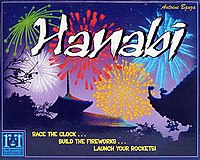Hanabi (card game)
 The box cover of Hanabi | |
| Designers | Antoine Bauza |
|---|---|
| Publishers | Asmodée Éditions |
| Players | 2 to 5 |
| Setup time | 5 minutes |
| Playing time | 20-30 minutes |
| Chance | Medium |
| Age range | 8 and up |
| Skills | Deduction, Memory, Cooperation, Planning |
Hanabi is a cooperative card game published in 2010[1] in which players, aware of other players' cards but not their own, attempt to play a series of cards in a specific order to set off a simulated fireworks show. Players are limited in the types of information they may give to other players, and in the total amount of information that can be given during the game. In 2013, Hanabi won the Spiel des Jahres, a prestigious industry award for best board game of the year.
Gameplay
The Hanabi deck contains cards in five suits (white, yellow, green, blue, and red): three ones, two each of twos, threes, and fours, and one five. The game begins with 8 available information tokens and 3 fuse tokens. To start the game, players are dealt a hand containing five cards (four for 4 or 5 players). As in Indian poker, each player holds his cards so that other players can see them but he cannot. Play proceeds around the table; each turn, a player must take one of the following actions:
- Give information: The player points out the cards of either a given number or a given suit in the hand of another player. The information given must be complete and correct. It is allowed to indicate that a player has zero of something. Giving information consumes one information token.
- Discard a card: The player chooses a card from his hand and adds it to the discard pile, then draws a card to replace it. The discarded card is out of the game and can no longer be played. Discarding a card replenishes one information token.
- Play a card: The player chooses a card from his hand and attempts to add it to the cards already played. This is successful if the card is a one of a suit that has not yet been played, or if it is the next number sequentially in a suit that has been played. Otherwise a fuse token is consumed and the misplayed card is discarded. Successfully playing a five of any suit replenishes one information token. Whether the play was successful or not, the player draws a replacement card.
Players lose immediately if all fuse tokens are gone, and win immediately if all fives have been played successfully. Otherwise play continues until the deck becomes empty, and for one full round after that. At the end of the game, the values of the highest cards in each suit are summed, resulting in a total score out of a possible 25 points.
Variants
- The game can be made easier by adding more information tokens, or more challenging by removing information or fuse tokens.
- The deck comes with a 6th "rainbow" suit which can be added to the base game as either just an additional suit, or with the special rule that rainbow cards can not be pointed out as such, but instead must be treated as if they belonged to all other suits simultaneously.
Awards
- 2013 Spiel des Jahres winner[2]
- 2013 Fairplay À la carte Award winner[3]
References
- ^ "Hanabi | Board Game | BoardGameGeek". boardgamegeek.com. Retrieved 2016-01-24.
- ^ "Spiel des Jahres official site: 2013 winner".
- ^ "Fairplay Online: À la carte prize 2013". (in German)
External links
- Hanabi at BoardGameGeek
- Seagull, Jon (29 September 2014). "Hanabi: card game with the goal to launch a spectacular firework display". Boing Boing. Retrieved 7 June 2015.
- Hirotaka Osawa (1 April 2015). "Solving Hanabi: Estimating Hands by Opponent's Actions in Cooperative Game with Incomplete Information". www.aaai.org. AAAI Workshops at the Twenty-Ninth AAAI Conference on Artificial Intelligence. Retrieved 2015-06-07.
